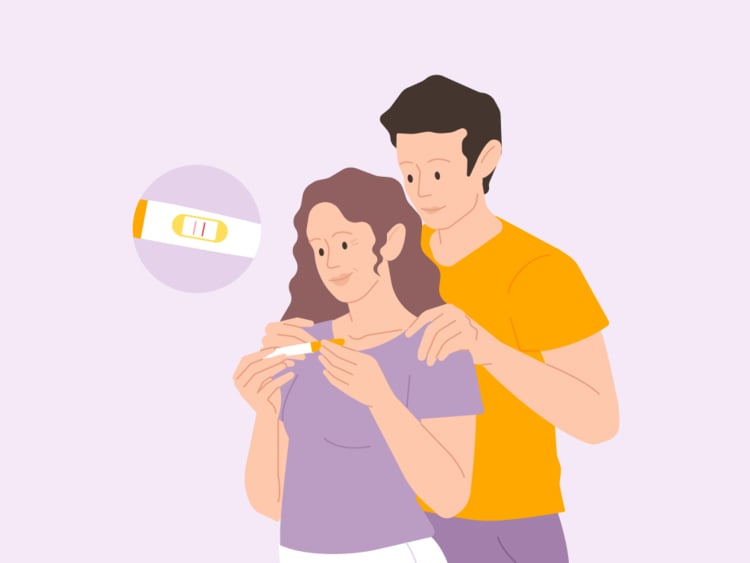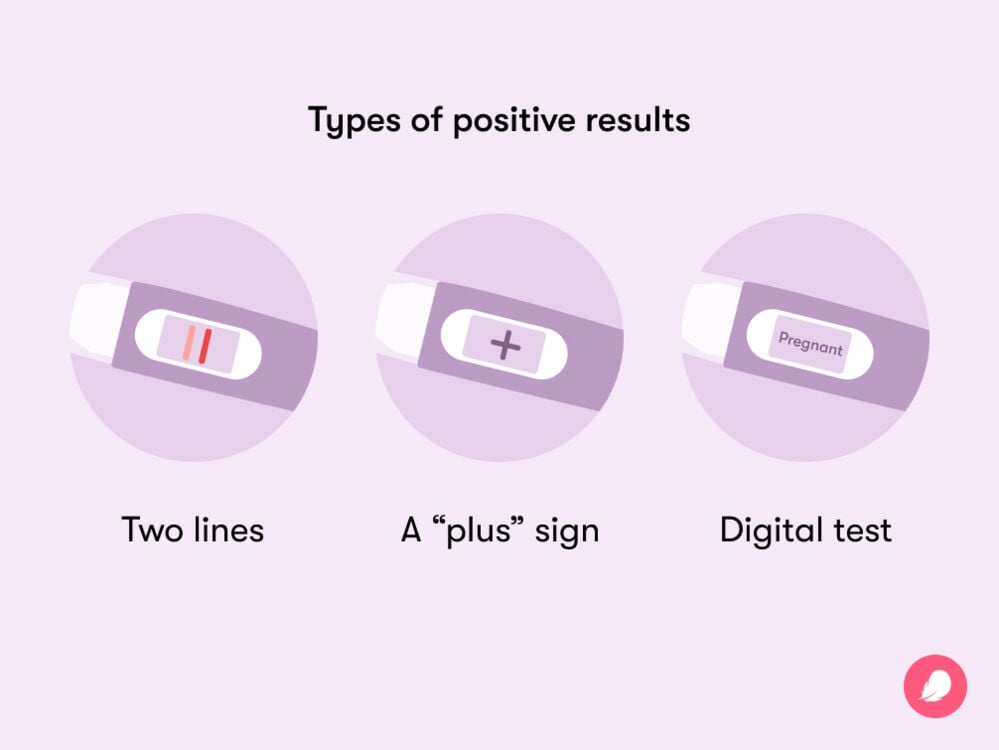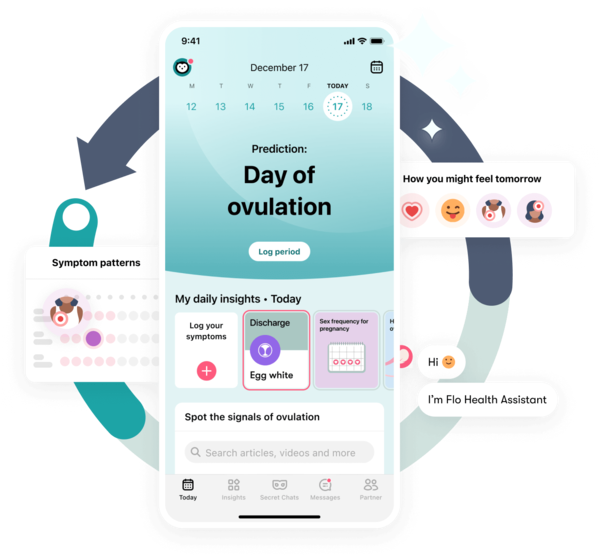Confused by this acronym? Here’s what BFP means in pregnancy and how to spot one.
-
Tracking cycle
-
Getting pregnant
-
Pregnancy
-
Help Center
-
Flo for Partners
-
Anonymous Mode
-
Flo app reviews
-
Flo Premium New
-
Secret Chats New
-
Symptom Checker New
-
Your cycle
-
Health 360°
-
Getting pregnant
-
Pregnancy
-
Being a mom
-
LGBTQ+
-
Quizzes
-
Ovulation calculator
-
hCG calculator
-
Pregnancy test calculator
-
Menstrual cycle calculator
-
Period calculator
-
Implantation calculator
-
Pregnancy weeks to months calculator
-
Pregnancy due date calculator
-
IVF and FET due date calculator
-
Due date calculator by ultrasound
-
Medical Affairs
-
Science & Research
-
Pass It On Project New
-
Privacy Portal
-
Press Center
-
Flo Accuracy
-
Careers
-
Contact Us
What does BFP in pregnancy mean?


Every piece of content at Flo Health adheres to the highest editorial standards for language, style, and medical accuracy. To learn what we do to deliver the best health and lifestyle insights to you, check out our content review principles.
When you’re trying to conceive (TTC), it’s understandable to want to hear about other people’s experiences. Knowing you’re not alone in how you’re feeling is always comforting, after all. Plus, getting pregnant isn’t always as straightforward as your sex education classes made out. So, if you’ve found yourself scrolling fertility forums stuffed full of acronyms and abbreviations, you’re not alone.
It can take some time to get used to all the new lingo, though. Here, we explain one of the most common terms you might come across: “BFP,” plus what to do if that BFP hasn’t happened for you yet because we know it can be a difficult time.
Key takeaways
- “BFP” is a fertility forum acronym that means “big fat positive,” aka a positive pregnancy test result.
- Different brands of tests have different ways of showing the result. Positive pregnancy tests can show as two parallel lines, a plus sign, or even the word “pregnant” on digital tests.
- For the most accurate result, take your pregnancy test on the first day of your missed period or afterward — even though it can feel like a long wait.
- Even a faint line can indicate a positive result. Retest a few days later to double-check.
- If you’re worried about your fertility or confused about a pregnancy test result, reach out to your doctor.
What’s the meaning of BFP?
Wondering what “BFP” means? It’s one of the most-used acronyms in the TTC space, but if you’re new to it all, those three letters might mean very little to you.
Perhaps you’ve come across the phrase in Secret Chats, the anonymous community where Flo members share experiences and support each other. Here’s an example of how it might be used: “For days, I honestly thought my period was coming. But then I took a test, and there was my BFP.”
If you’ve never come across the term before, that sentence could be extremely confusing. But BFP simply means “big fat positive.” It’s what some people post as easy shorthand for a positive pregnancy test result.
What’s a BFP pregnancy test?
While “BFP” typically refers to someone’s positive pregnancy test, you might also come across BFP as a brand name for pregnancy tests and ovulation kits. Confusing, right? In this article, we’ll use BFP to refer to a positive test result rather than a pregnancy test itself.
What does a BFP look like?
A positive pregnancy test result should be pretty straightforward to read, right? Not always. Different brands use different methods to show that BFP (or a negative result, called a BFN for short). For a positive result, you might need to look out for:
- Two parallel lines: If both lines appear, it typically means your test is positive.
- A plus sign: Some tests show a plus sign (+) if you’re pregnant.
- Digital tests: These tend to display the word “pregnant” for a positive result.
With most home pregnancy tests, you put the end of the test in your pee stream or dip the test in a container of your urine. But it’s still important to read the instructions on your test carefully before you take it, says obstetrician and gynecologist Dr. Renita White from Georgia, US. The directions for use or how to interpret the results might not be the same as a pregnancy test you’ve used before. Double-check the expiration date, too. If it’s past that date, get a new one instead.

Knowing when to take a pregnancy test matters, says Dr. White. That’s because the result might not be accurate if you take it too early. So, how long should you wait? It’s best to hold off until you miss a period. Not sure when that might be? Period-tracking apps like Flo can help here. Simply log your period dates in the Flo app, and it will tell you when you should take a test. Alternatively, you could try using Flo’s online pregnancy test calculator for a rough idea.
And while you might think you’re looking for a big fat positive (aka a thick, noticeable line), Dr. White notes that even a faint result can mean pregnancy. “If a test has even the faintest sign of being positive, it is best to assume that it’s positive unless proven otherwise.”
If you’ve got a faint line on a pregnancy test, take another test in a few days, she adds. Pregnancy tests measure a hormone in your urine called human chorionic gonadotropin (hCG). Think of this as the pregnancy hormone that rises after you conceive and continues to increase in early pregnancy. If you test too early, there might not be enough hCG in your pee for the test to detect.
If you’re still unsure about a pregnancy test result or you’ve had mixed results, visit your health care provider for a blood test. They can check your hCG levels more accurately with a blood test than a home test so you’ll know if you’re pregnant or not, says Dr. White.
How to improve your chances of a BFP
Waiting and hoping for a BFP can be all-consuming. While there is no shortcut to getting a positive pregnancy result — and everyone’s fertility journey is different — it’s important to make sure you understand how to time conception sex. The best way to do this is by tracking your ovulation.
Ovulation is when your ovaries release an egg (aka the big moment in your cycle when you’re TTC). Stocking up on ovulation kits — or using an ovulation-tracking app like Flo to learn about the signs of ovulation — can help you to understand when in your cycle you’re likely to be ovulating and therefore most fertile. With that intel, you can plan the best time to have sex to get pregnant. “Studies show that the ideal way to maximize conception is to have sex every other day during your fertile window,” says Dr. White. Other ovulation-tracking methods — like watching for symptoms (such as stretchy, egg white-like discharge) or testing your basal body temperature daily — can also help flag the best time to try to get pregnant.
If you want to make sure you’re using your home pregnancy test properly, there are some ways to improve your chances of getting an accurate result. These include:
Not testing too early: For the most accurate result, take your pregnancy test around 14 days after you likely ovulated (14 DPO) or on the first day of your missed period. Testing too early can lead to false negatives, so try to be patient, even though the wait can feel long.
Taking the test when you first wake up: Consider using your first pee of the day for your test, says Dr. White. HCG levels are usually more concentrated when you wake up, making it easier to pick up a BFP.
Setting a timer: As tempting as it might be, don’t check the test until the amount of time the directions tell you to wait has passed. This gives you the best chance of getting an accurate result.
Getting a negative pregnancy test can be hard to deal with when you’re TTC, so try to go easy on yourself. Feelings of frustration and disappointment are completely normal. Surround yourself with support and make time for things that you enjoy. Remember that it’s perfectly normal if it takes you some time to get pregnant. It happens within a year for 85% of couples.
Other acronyms you may need to know
BFP probably won’t be the only acronym you come across in your TTC journey. For a full cheat sheet for those fertility forums, check out our fertility abbreviations page.
But there are also a few key terms worth knowing in addition to BFP.
- BFN: This means big fat negative, i.e., a negative pregnancy test
- HPT: Home pregnancy test
- DPO: Days past ovulation
Take a quiz
Find out what you can do with our Health Assistant
Still waiting for your BFP?
Hopefully, knowing BFP and a few other major acronyms will help you navigate your TTC journey with a little more ease. But if you’re constantly scrolling through fertility forums, it’s worth checking in with yourself and considering how they’re making you feel — and whether they’re ultimately helping you or not.
“Trying to conceive can be emotionally taxing and isolating, especially since many people don’t tell others that they are currently trying,” says Dr. White.
So, while fertility forums can provide much-needed support to people who know how hard it can be to get pregnant, it’s all too easy to compare yourself to others. And it’s only natural to feel frustrated if someone arrives at that BFP more quickly than you.
Make sure you’re being kind to yourself. Dr. White recommends taking some time to explore self-care techniques that work best for you in stressful and unpredictable situations. “Consider healthy distractions like trying new things and spending time with people you enjoy,” she says.
And if you’re worried it’s taking some time to conceive, don’t be afraid to speak to your doctor. It’s recommended that you book an appointment if you’re under 35 and have been trying for over a year. If you’re over 35, see your doctor if it’s been more than six months, and if you’re over 40, it’s best to go right away.
Frequently asked questions about BFP
Can a faint line be a BFP?
Even if you can only see a faint line on your pregnancy test, it could still signal a BFP. Dr. White advises treating even the faintest line as a positive result. But test again in a few days to double-check.
How many DPO will a pregnancy test be positive?
Some brands of pregnancy tests promise an accurate result as early as six days post-ovulation. However, experts recommend waiting to test until the first day of your missed period. Testing too early can mean the levels of pregnancy hormone hCG in your pee are too low for the test to detect. If you’re not sure when your period is due or you don’t have a regular menstrual cycle, do the test at least 21 days after you last had unprotected sex.
Can a positive pregnancy test be wrong?
False positive pregnancy tests are rare, says Dr. White. But they are possible. “It can happen if the test has expired or if it’s read after the appropriate period of time,” she explains. A false positive might also happen if you take fertility medicine that contains hCG. Chat with your doctor if you’re worried about a false positive or anything else related to getting pregnant.


Hey, I'm Anique
I started using Flo app to track my period and ovulation because we wanted to have a baby.


The Flo app helped me learn about my body and spot ovulation signs during our conception journey.


I vividly
remember the day
that we switched
Flo into
Pregnancy Mode — it was
such a special
moment.
Real stories, real results
Learn how the Flo app became an amazing cheerleader for us on our conception journey.
References
“Causes of a False Positive Pregnancy Test.” Cleveland Clinic, 18 Oct. 2021, health.clevelandclinic.org/false-positive-pregnancy-test.
“Evaluating Infertility.” The American College of Obstetricians and Gynecologists, Jan. 2020, www.acog.org/womens-health/faqs/evaluating-infertility.
“Home Pregnancy Tests: Can You Trust the Results?” Mayo Clinic, 23 Dec. 2022, www.mayoclinic.org/healthy-lifestyle/getting-pregnant/in-depth/home-pregnancy-tests/art-20047940.
“Human Chorionic Gonadotropin.” Cleveland Clinic, https://my.clevelandclinic.org/health/articles/22489-human-chorionic-gonadotropin. Accessed 12 Aug. 2022.
Ogle, Alicia. “Using Ovulation Tools to Predict Fertility.” Mayo Clinic Health System, 13 June 2023, www.mayoclinichealthsystem.org/hometown-health/speaking-of-health/using-ovulation-kits-to-predict-fertility.
“Pregnancy Tests.” Cleveland Clinic, my.clevelandclinic.org/health/diagnostics/9703-pregnancy-tests. Accessed 5 Sep. 2024.
“Session 24: Ovulation and Fecundity.” Human Reproduction, vol. 25, suppl. 1, June 2010, pp. I37–i38, https://doi.org/10.1093/humrep/de.25.s1.24.
“What Ovulation Signs Can I Watch for if I Want to Get Pregnant?” Mayo Clinic, 9 July 2024, www.mayoclinic.org/healthy-lifestyle/getting-pregnant/expert-answers/ovulation-signs/faq-20058000.
History of updates
Current version (23 September 2024)
Published (19 February 2019)
In this article

Get your personal guide to fertility
-
Learn how to read your body's ovulation signals
-
Find daily conception tips from our experts
-
Chat with others who are trying to get pregnant




